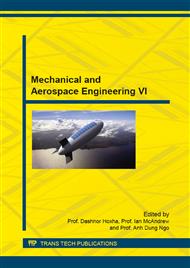p.140
p.148
p.155
p.160
p.165
p.170
p.175
p.180
p.185
Determination of the Diameter of a Cylinder to Insertion in a Low-Speed Wind Tunnel Based on EFD and CFD
Abstract:
The objective of this study was to determine the ideal diameter of a circular cylinder for insertion into the test section of a small wind tunnel, so that there was no flow blockage and influence of the developing wind tunnel boundary layer in the flow around the cylinder. The approaches used were the experimental fluid dynamics (EFD) by the use of Pitot tube and hot wire anemometer (HWA) and the computational fluid dynamics (CFD) simulations, performed with ANSYS CFX software. For this, it was first determined the boundary layer thickness along the test section without the cylinder, through computer simulations. Based on this information, several simulations were performed with cylinders of different diameters to quantify their influence on the rotational flow. From the four studied cylinder diameters, it was found that only the one with 30 mm did not cause bending of the streamlines at the intersection with the boundary layer developing in the tunnel. Moreover, this was the minimum diameter of the cylinder so that the tests with Pitot probe could be used without disturbances caused by its dimensions in the flow to be characterized. After analyzing these results, the cylinder of 30 mm was built and the experimental tests were performed, validating the numerical results.
Info:
Periodical:
Pages:
165-169
Citation:
Online since:
October 2015
Keywords:
Price:
Сopyright:
© 2015 Trans Tech Publications Ltd. All Rights Reserved
Share:
Citation:


